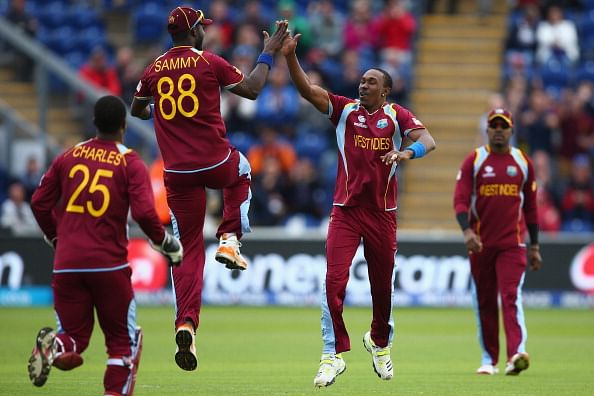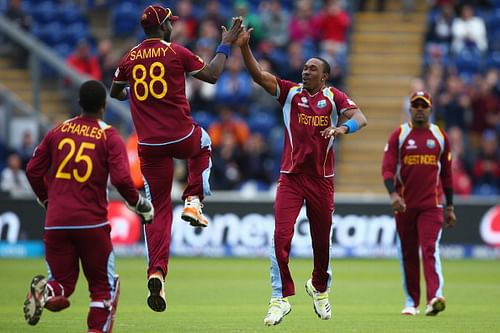
West Indies - Lessons from the ICC Champions Trophy 2013

Dwayne Bravo(2R) of West Indies high fives Darren Sammy (2L) after capturing the wicket of JP Duminy of South Africa during the ICC Champions Trophy Group B match between West Indies and South Africa at the SWALEC Stadium on June 14, 2013 in Cardiff, Wales. (Getty Images)
It is an emotion widely felt in cricketing circles around the world that it will be a great boost to international cricket if the West Indies can pull up their socks and perform at a level they once used to.
While that maybe a noble emotion, it involves an element of nostalgia for the past. It ignores the current state of West Indies cricket where there is a marked lack of tall, genuinely fast bowlers; where currently the biggest bowling weapon they have is a ‘mystery spinner’ called Sunil Narine.
West Indies have however managed to preserve their Richardsonian philosophy of batting: hit hard, hit far. The likes of Chris Gayle and Kieron Pollard are an illustration of that. West Indian cricket needs to find acceptance on its own terms and a part of that is moving away from the overwhelming legacy.
It has seen a few good years in the recent past and has developed into a good limited overs side. They have a number of all-rounders who can perform multiple roles for the side and that is always an advantage. New talent is also coming forth as the likes of Jason Holder and Johnson Charles look promising.
Their eviction from the group stage of the Champions trophy was a bit of an unfortunate incident as they bowed out in spite of losing just one match in the tournament. The rain interrupted match against South Africa made a mockery of their ambitions as it ended tied by D/L method. It all came down to one ball, one false shot.
However, that is not to say that it was plain misfortune. West Indies would have probably lost that match if it was not curtailed at all. As laudable as their performance against Pakistan in the first group game was, it was not convincing by any means. They were chasing a meagre total of 170 and still lost eight wickets in the process with Gayle contributing 39 runs as the highest scorer for the side.
He was the only batsman in the side, throughout the competition, who tried to curb his natural instinct in conditions that were not ideally suited to blind hitting. The idea was to use R. Sarwan in an anchor role as the side was largely constituted by big-hitters and so called ‘T-20 specialists’. The execution of that idea was terrible as Sarwan came out to bat at no.5 instead of the more suitable one-down position.
West Indies’ primary problem in the Champions Trophy was the performance with the bat. In their second group game against India, fortune favoured them as they found batting friendly conditions and had the opportunity to play without pressure as they were putting runs on the board. The top order did decently well with Johnson Charles contributing a handsome 60 runs but then the middle order failed to capitalise.
Marlon Samuels, who is now a senior player in this side and a leader, is capable of getting those big innings for the West Indies. He has a number of shots in his repertoire and can utilise the pace of the ball and can hit through the line. He needs to step-up his game and perform for the West Indies at critical moments. He failed in that match as he tried to be adventurous too early on in the innings; a fault many West Indian batsmen are prone to, and Sarwan, batting at no.5 again, followed him soon after.